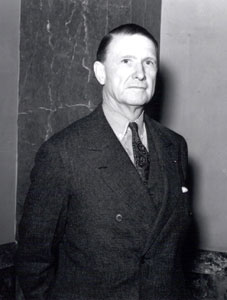
Luke Lea
A key figure in the reform and prohibition movements and a major player in the early twentieth-century Democratic Party, Luke Lea was prominent in Tennessee history during the early twentieth century. A descendant of the pioneer Overton and Cocke families, Lea was the son of Ella Cocke and Overton Lea. He was born and reared at Lealand, the family’s one-thousand-acre farm on the outskirts of Nashville.
Lea was tutored at home until he entered the University of the South at Sewanee in the spring of 1896. While at Sewanee, he managed the fabled 1899 football team. He received his bachelor’s degree in 1899 and his master’s in 1900. In 1903 he earned a law degree from Columbia University, where he edited the Columbia Law Review.
After graduation, Lea returned to Nashville to practice law. He burst upon the political horizon when he seized the gavel at the chaotic 1906 Democratic state convention and brought the delegates to order. An ardent prohibitionist, he battled to free the state from what he considered the corrupt domination of the liquor interests and railroads. With his crusading spirit, supreme self-confidence, and incredible energy, he made bitter political enemies and staunch friends. Like many men drawn to reform and politics, Lea established a newspaper, the Nashville Tennessean, in 1907.
In 1911 a Fusionist coalition of dry Democrats and Republicans elected Lea to the U.S. Senate. There he worked for passage of far-reaching progressive measures. On the state level, he continued to support election law reform and enforcement of temperance legislation. Following the attainment of those goals, he attempted to reunify the splintered Democratic Party, but was defeated in the first popular primary held fifteen months before the expiration of his term.
When the United States entered World War I, Lea put aside his own aversion to the war and raised and commanded a volunteer regiment. The 114th Field Artillery distinguished itself in France in the battles of St. Mihiel, the Meuse Argonne, and the Woevre Plains.
After the armistice, Lea gained worldwide attention by leading a small group of American soldiers into Holland, where the former German Kaiser had been granted asylum. Lea hoped to persuade the Kaiser to go to Paris and risk being tried for war crimes rather than place the German people under the burden of heavy war reparations, an outcome that Lea correctly foresaw as sowing the seeds for a future world conflict. A washed-out bridge over a branch of the Rhine obstructed Lea’s plans, however, and the Versailles meeting proceeded without the Kaiser.
Lea returned home and played an influential role in the founding of the American Legion. He also resumed active management of his newspaper and leadership of the rural progressive faction of the state Democratic Party. His political activities once again placed him in opposition to the Nashville and Memphis machines, especially that of Edward H. Crump of Memphis, except during brief periods of “armed” truce.
An increasingly strong voice of support for Governor Austin Peay, Lea influenced Tennessee public policy in the 1920s. He strongly supported highway construction, public education, tax revision, and modernization of state government. He advocated the veteran’s bonus, taxes on luxuries such as tobacco, unionization of labor, woman suffrage, and the establishment of the Great Smoky Mountains National Park.
During the 1920s, often in alliance with financier Rogers Caldwell, Lea established a publishing empire. He acquired two other city newspapers, the Memphis Commercial Appeal and the Knoxville Journal. He invested in Nashville real estate, especially in the prestigious residential suburb of Belle Meade. In 1927 he donated the original 868 acres of Percy Warner Park to the city of Nashville, with the request that the park be named for his father-in-law. At the zenith of his financial and political influence, Lea declined an appointment to the U.S. Senate in 1929.
With the onset of the Great Depression and the spectacular failure of Caldwell and Company in 1930, Lea’s political and publishing empires began to crumble. He lost control of the Memphis and Knoxville newspapers, and in 1933 the Nashville Tennessean was placed in receivership. Creditors foreclosed on many of his large real estate holdings. The general assembly launched an investigation into the loss of state funds deposited in banks associated with Lea and threatened his ally, Governor Henry Horton, with impeachment. Investigators scrutinized Lea’s transactions but brought no charges.
In Asheville, North Carolina, however, indictments were returned against Lea as a result of the failure of the Central Bank and Trust Company. Certain of his innocence, Lea waived his legal rights and voluntarily traveled to North Carolina to answer the charges. When the trial began, the original indictments were quashed and new ones returned, on which he was forced to stand trial immediately. The trial took place in a highly charged atmosphere, and Lea was convicted of banking law violations. He appealed the verdict and waged a lengthy, but unsuccessful, battle to remain free. While he was incarcerated in the North Carolina state prison, an independent audit by A. M. Pullen and Company proved his innocence. He was paroled in 1936 after twenty-three months in prison and received a full pardon the following year. He spent the rest of his life involved in public relations work in Washington, D.C.
Lea married Mary Louise Warner in 1906, and they had two sons, Luke Lea Jr. and Percy Warner Lea. Lea’s first wife died in 1919 while he was aboard ship on the return voyage from France after World War I. In 1920 he married Percie Warner, the youngest sister of his first wife. They had three children, Mary Louise, Laura, and Overton.



